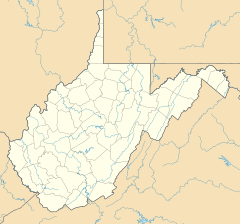Pruntytown, West Virginia facts for kids
Quick facts for kids
Pruntytown
|
|
|---|---|
| Country | United States |
| State | West Virginia |
| County | Taylor |
| Elevation | 1,204 ft (367 m) |
| Time zone | UTC-5 (Eastern (EST)) |
| • Summer (DST) | UTC-4 (EDT) |
| GNIS feature ID | 1545306 |
Pruntytown is an unincorporated community at the junction of the Northwestern Turnpike (U.S. Route 50) and U.S. Route 250 in Taylor County, West Virginia, USA. It is the site of the Pruntytown Correctional Center (formerly West Virginia Industrial Home for Boys).
History
The first settlement at Pruntytown (the earliest known white settlement in what is now Taylor County) was made circa 1798 with pioneers John Prunty, Sr (1745-1823) and his son David (1768-1841). It was initially known as Cross Roads, from the intersection there of the old Clarksburg Pike and the old Beverly and Fairmont Road. On January 1, 1801 Cross Roads was renamed Williamsport in honor of Abraham Williams, a local resident.
The name "Prunty Town" appears in an 1835 gazetteer, which describes the status of the town at the time:
It contains 18 dwelling houses, 1 Methodist and 1 Baptist house of worship, 1 common school, 3 miscellaneous stores, 1 tavern, 1 tanyard, 2 saddlers, 2 boot and shoe factories, 1 hatter, 1 tailor, 2 smith shops, 1 gun smith, and 1 cabinet maker. Population 110. The surrounding country is somewhat broken, but the soil is good, and well adapted to the grazing of cattle; and growing every species of small grain.
The name change was made official on January 23, 1845 to honor the Pruntys. This town served as the county seat from the county's founding in 1844 until a county election in 1878 moved it approximately three miles away, to Grafton.
Notable person
- John Barton Payne (1855–1935), Pruntytown-born lawyer and U.S. Secretary of the Interior (1920–21)



